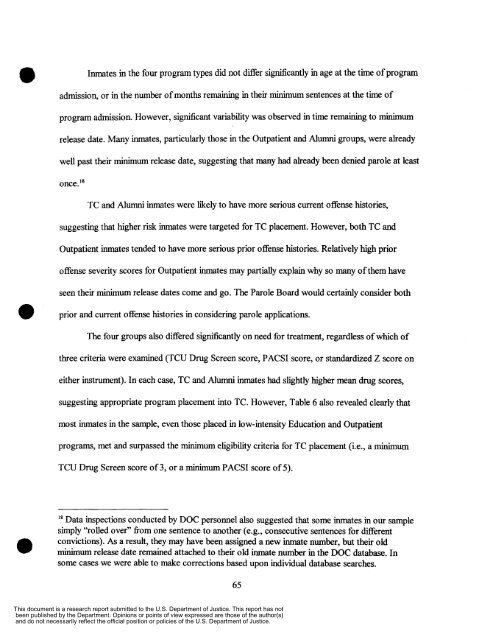0 - National Criminal Justice Reference Service
0 - National Criminal Justice Reference Service
0 - National Criminal Justice Reference Service
You also want an ePaper? Increase the reach of your titles
YUMPU automatically turns print PDFs into web optimized ePapers that Google loves.
Inmates in the four program types did not differ significantly in age at the time of program<br />
admission, or in the number of months remaining in their minimum sentences at the time of<br />
program admission. However, significant variability was observed in time remaining to minimum<br />
release date. Many inmates, particularly those in the Outpatient and Alumni groups, were already<br />
well past their minimum release date, suggesting that many had already been denied parole at least<br />
once.”<br />
TC and Alumni inmates were likely to have more serious current offense histories,<br />
suggesting that higher risk inmates were targeted €or TC placement. However, both TC and<br />
Outpatient inmates tended to have more serious prior offense histories. Relatively high prior<br />
offense severity scores for Outpatient inmates may partially explain why so many of them have<br />
0<br />
seen their minimum release dates come and go. The Parole Board would certainly consider both<br />
prior and current offense histories in considering parole applications.<br />
The four groups also differed significantly on need for treatment, regardless of which of<br />
three criteria were examined (TCU Drug Screen score, PACSI score, or standardized Z score on<br />
either instrument). In each case, TC and Alumni inmates had slightly higher mean drug scores,<br />
suggesting appropriate program placement into TC. However, Table 6 also revealed clearly that<br />
most inmates in the sample, even those placed in low-intensity Education and Outpatient<br />
programs, met and surpassed the minimum eligibility criteria for TC placement (i.e., a minimum<br />
TCU Drug Screen score of 3, or a minimum PACSI score of 5).<br />
0<br />
Data inspections conducted by DOC personnel also suggested that some inmates in our sample<br />
simply “rolled over” fi-om one sentence to another (e.g., consecutive sentences for different<br />
convictions). As a result, they may have been assigned a new inmate number, but their old<br />
minimum release date remained attached to their old inmate number in the DOC database. In<br />
some cases we were able to make corrections based upon individual database searches.<br />
65<br />
This document is a research report submitted to the U.S. Department of <strong>Justice</strong>. This report has not<br />
been published by the Department. Opinions or points of view expressed are those of the author(s)<br />
and do not necessarily reflect the official position or policies of the U.S. Department of <strong>Justice</strong>.
















